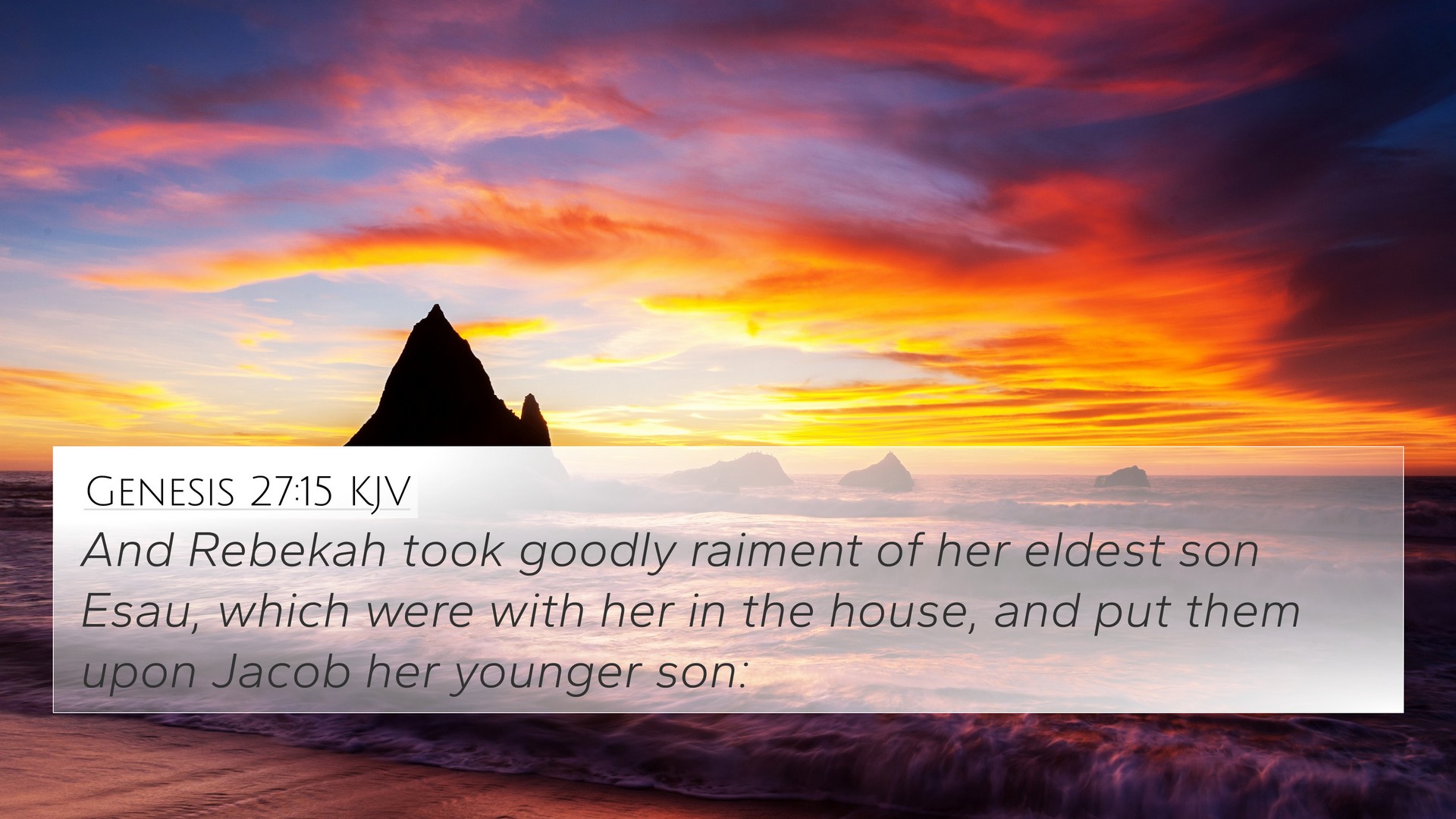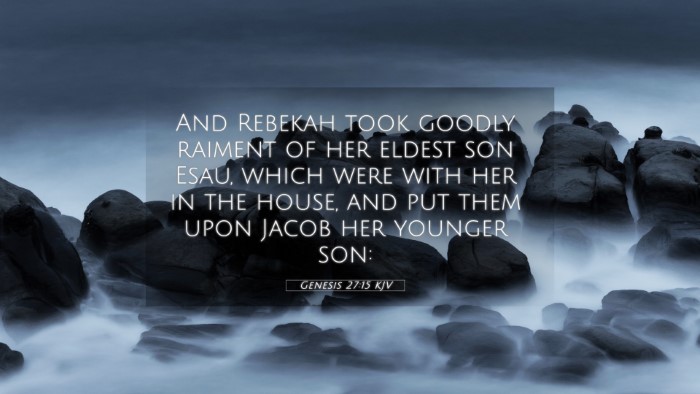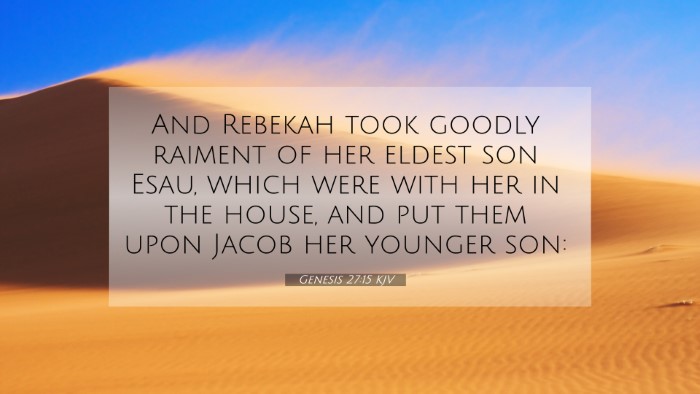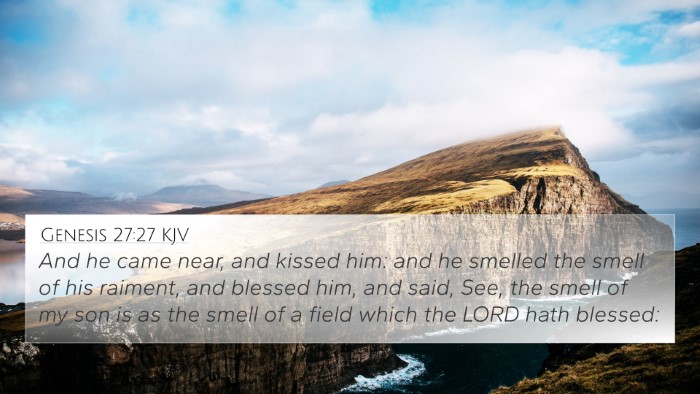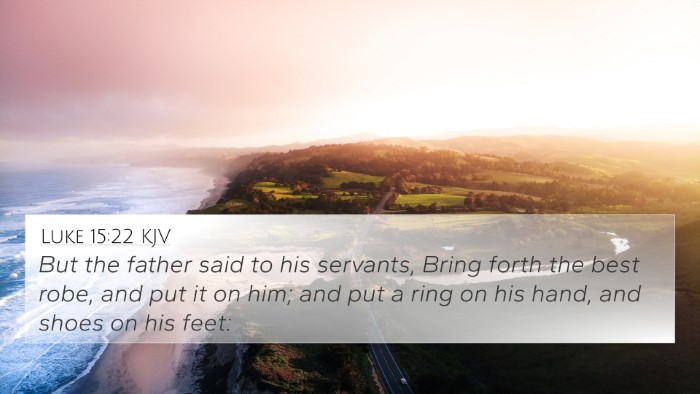Understanding Genesis 27:15
Genesis 27:15 states: “Then Rebekah took the best garments of her elder son Esau, which were with her in the house, and put them upon Jacob her younger son.” This simple yet profound verse is laden with narrative significance and thematic depth.
Summary of the Verse
In this passage, Rebekah, the mother of Jacob and Esau, crafts a plan to secure her younger son Jacob the blessing meant for his elder brother, Esau. By dressing Jacob in Esau's garments, she aims to disguise him, making him appear as the firstborn. This serves as a pivotal moment in the Jacob and Esau narrative, highlighting themes of deception, familial loyalty, and the fulfillment of divine prophecy.
Commentary Insights
Matthew Henry's Commentary
Henry emphasizes the cunning nature of Rebekah’s actions, reflecting on the complexity of human relationships and divine sovereignty. He suggests that despite her questionable methods, Rebekah's intentions stem from a belief in God's prophecy regarding Jacob's preeminence over Esau (Genesis 25:23). This highlights the moral ambiguity present in the Biblical narrative, where good intentions can lead to ethically problematic outcomes.
Albert Barnes' Commentary
Barnes notes that Rebekah's decision to use Esau's garments serves a dual purpose: it not only camouflages Jacob but also invokes the senses of his blind father, Isaac. This physical representation emphasizes the importance of the birthright and the cultural significance of blessings in ancient Hebrew society. The verse illustrates the lengths to which individuals will go for familial allegiance and the desire for divine favor.
Adam Clarke's Commentary
Clarke elaborates on the symbolism of the garments. He explains that clothing represents identity and position within the family. By wearing Esau's fur-covered garments, Jacob takes on a false identity, which brings to light profound questions about authenticity and deception. Clarke urges readers to consider the broader implications of how one’s appearance can shape perceptions and relationships.
Thematic Connections
This verse bridges numerous Biblical themes, including:
- Divine Sovereignty: The manipulation of circumstances to fulfill God’s promise (Genesis 25:23).
- Deception: The moral complexities within the family dynamic (Genesis 27:22-23).
- Identity: The significance of names and roles in the unfolding narrative (Genesis 32:28).
- Sibling Rivalry: The dynamics between Jacob and Esau that echo throughout their story (Genesis 27:41).
- Parental Favoritism: The detrimental effects of favoritism in families (Genesis 25:28).
- Faith and Obedience: The tension between human actions and divine will (Romans 9:10-13).
- Consequences of Sin: The long-term ramifications of deceitful acts (Genesis 33:4).
Cross-References
This verse connects with various Scriptures that illustrate similar themes or narrative elements:
- Genesis 25:23 - God’s prophecy about the two nations within Rebekah.
- Genesis 27:22-23 - Jacob deceives Isaac with Rebekah’s help.
- Genesis 27:41 - The beginning of Esau’s hatred toward Jacob.
- Genesis 31:1 - Jacob’s fear of Esau when returning to Canaan.
- Romans 9:10-13 - New Testament referencing of Jacob and Esau's story.
- Hebrews 12:16-17 - Esau’s loss of his birthright and its consequences.
- Galatians 4:29 - The allegorical connection between children of promise and flesh.
Inter-Biblical Dialogue
The interactions and themes originating in Genesis 27 have ripple effects throughout Scripture. The manipulation of God's will through human action raises significant theological questions about free will, divine election, and the moral implications of our choices.
In considering how to find cross-references and identifying connections between Old and New Testaments, this passage serves as an excellent study on the continuity of themes throughout Scripture. Observing how these moments are reflected in later narratives enhances our understanding of God's unfolding story.
Conclusion
Genesis 27:15 offers a rich landscape for study and reflection. By cross-referencing this verse, one can explore the depths of deception, identity, family dynamics, and divine prophecy. It is a clear example of the complexities that arise in the human experience and the timeless nature of Biblical teachings.
Further Study Suggestions
For those engaging in cross-reference Bible studies or seeking deeper insights, consider utilizing a Bible concordance or the numerous Bible reference resources available to track the thematic connections. Engaging with comprehensive materials can provide clarity and foster a richer understanding of the interconnectedness of Scripture.
